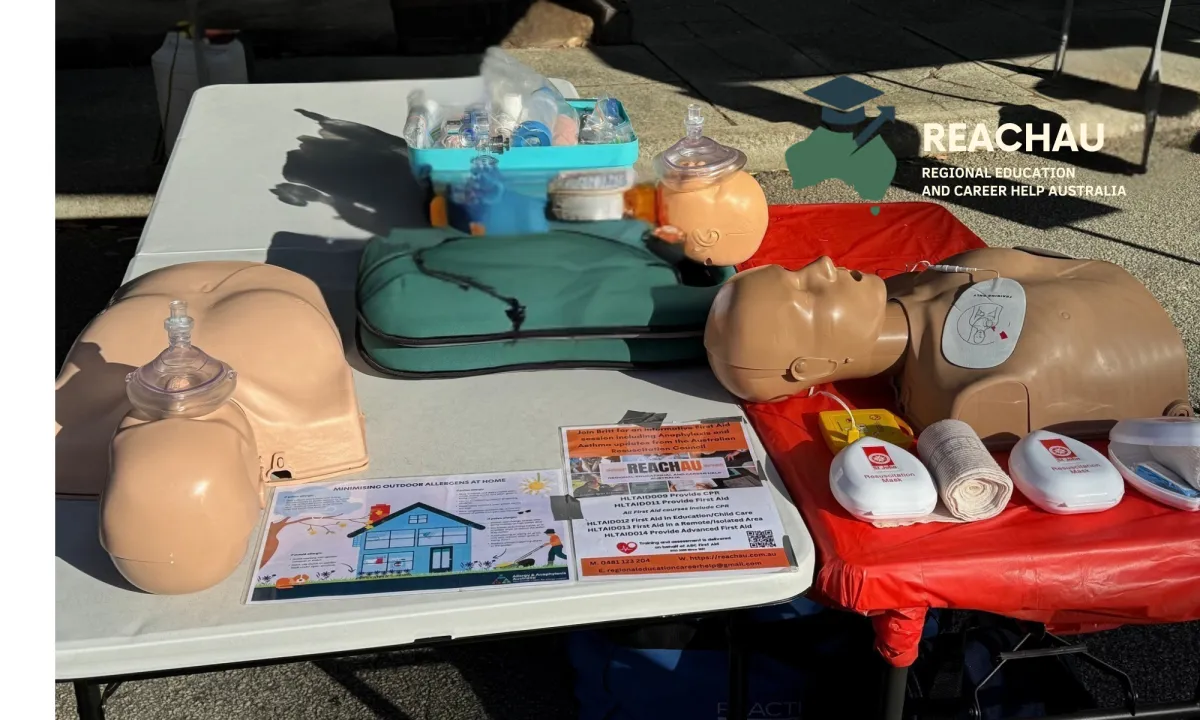
CPR & AEDs: 10 Critical Questions Answered for Australians
Every minute counts when someone’s heart stops. CPR isn’t just a skill, it’s the bridge between life and death before paramedics arrive.
These REACHAU articles unpack real-world stories, research, and quick tips to keep you ready when emergencies strike. From bystander CPR to defibrillator use, you’ll find practical advice that builds calm confidence under pressure.
Refresh your knowledge, share it with your team, and help create communities that act fast, not freeze, when cardiac arrest happens.
CPR & AEDs: 10 Critical Questions Answered for Australians
Every second counts in a cardiac arrest.
Here are the 10 most common CPR and defibrillator (AED) questions Australians ask-answered in clear, practical steps so you feel confident the next time it matters.
1. Why do I need to refresh CPR every 12 months?
Technically, your certificate lasts 3 years, but the Australian Resuscitation Council (ARC) recommends a refresher every 12 months. Why? Because:
Skills fade faster than you think.
New guidelines are updated regularly.
Confidence comes from practice.
👉 How to stay compliant: Set a reminder on your phone for 11 months after your last CPR course and book in straight away.
2. What should I do if someone collapses and there’s no AED nearby?
AEDs save lives, but don’t freeze if there isn’t one.
Step 1: Call 000 immediately.
Step 2: Start chest compressions (100-120 per minute, centre of chest, 5cm depth).
Step 3: Get someone else to search for an AED while you continue CPR.
👉 Bottom line: Continuous CPR keeps oxygen moving until help-or an AED-arrives.
3. Why do people forget to send for a defibrillator at a car crash site?
Stress makes the brain “check out.” People focus on obvious dangers-glass, fuel, blood-and forget the simple lifesaving step: send someone for the AED.
👉 How to fix this: Before you start CPR, point to someone specific and say:
“You-go find the AED!”
4. How do I use an AED if I’ve never touched one before?
AEDs are designed for ordinary people, not paramedics.
Open it.
Turn it on.
Follow the voice prompts.
Pads are labelled with diagrams. The machine will not shock unless it detects a rhythm that needs it.
👉 Tip: Don’t overthink. Just stick it on and follow the prompts.
5. What are the survival rates if CPR and an AED are used immediately?
Without intervention → survival in Australia is about 10%.
With early CPR + AED → survival can triple to 30% or higher.
👉 Translation: Sending for the AED is the difference between life and death.
6. How do I stay calm enough to do CPR in a real emergency?
You probably won’t feel calm. That’s normal. But training kicks in like muscle memory.
Focus on just the next step: push, push, push.
Count out loud.
Swap with another rescuer every 2 minutes if possible.
👉 Remember: Doing something is better than doing nothing.
7. What if I break someone’s ribs while doing CPR? Am I liable?
Broken ribs are common in CPR-because effective compressions need force.
The law protects you under Good Samaritan principles in Australia if you act in good faith.
A cracked rib is survivable. Death from no CPR is not.
8. What’s the difference between CPR for adults, children, and infants?
Adults: 2 hands, 30 compressions: 2 breaths.
Children (1-8 years): 1 hand, 30:2.
Infants (<1 year): 2 fingers, 30:2.
👉 Tip: If you forget the ratios-just do compressions. Chest compressions alone are better than hesitation.
9. How do I know when to stop CPR if help hasn’t arrived?
Keep going until:
The person starts breathing normally.
Paramedics take over.
You are physically unable to continue.
👉Stopping early can cost a life.
10. Am I legally protected if I try CPR and it doesn’t work?
Yes. In Australia, Good Samaritan laws protect you as long as:
You acted in good faith.
You didn’t expect payment.
You weren’t grossly negligent.
👉Put simply: you won’t get sued for trying to save a life.
📌Final Word
CPR isn’t about perfection-it’s about action. Early CPR and a defibrillator can triple survival. But skills fade, which is why practice is everything.
👉 [Book your CPR or First Aid course with REACHAU today] - where I’ll show you step-by-step until it becomes second nature. Don’t wait for an emergency to find out you’re not ready.
